The Cu Chi tunnels life represents one of history’s most extraordinary examples of human adaptation and resilience. During the Vietnam War, these elaborate underground passages became home to thousands of Vietnamese people who spent years living beneath the earth while conflict raged above. Stretching over 250 kilometers in length and featuring multiple levels descending up to 12 meters underground, this remarkable network housed entire communities who adapted to the harsh conditions of subterranean existence.
This article explores the realities of life in the Cu Chi Tunnels during the war, examining how ordinary people managed to create functioning communities despite extraordinary challenges. From basic survival needs to complex social structures, the story of living in Cu Chi tunnels offers profound insights into human determination and ingenuity during one of history’s most devastating conflicts.
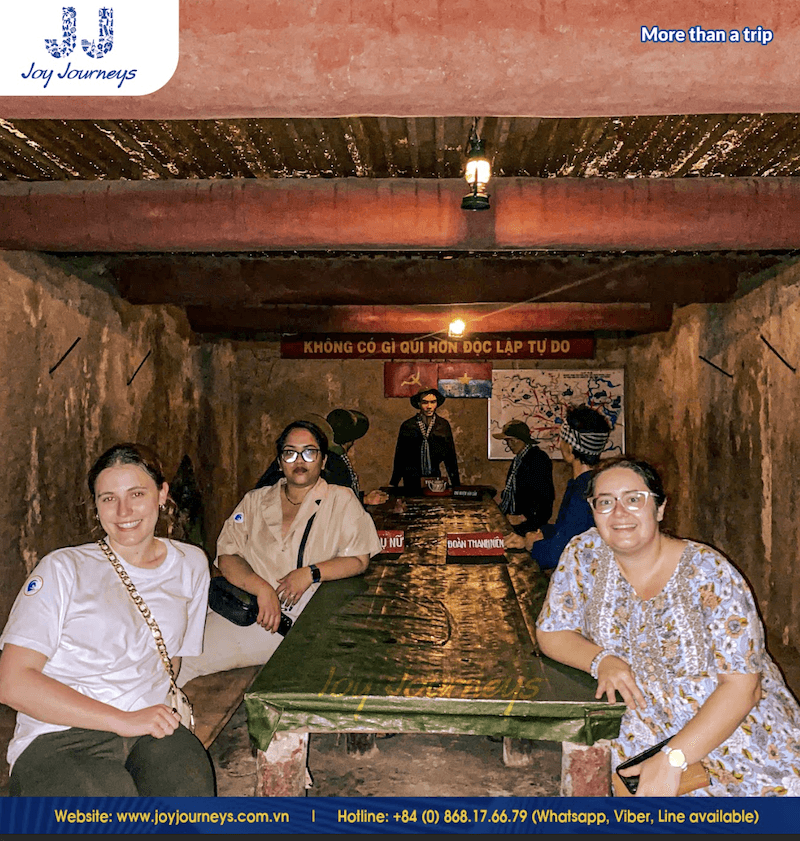
Contents
- 1 Cu Chi Tunnels Life: What daily living was really like?
- 2 The Tunnel Community
- 3 Life in the Cu Chi Tunnels during the war: Challenges and Dangers
- 3.1 The Constant Threat of Attack
- 3.2 How Did People Survive in the Cu Chi Tunnels Despite Health Risks?
- 3.3 Life Underground Cu Chi: The Psychological Challenges of Tunnel Living
- 3.4 Ingenuity and Resilience in Daily Life in the Cu Chi Tunnels
- 3.5 Living in Cu Chi Tunnels: Clever Innovations for Survival
- 3.6 Maintaining Morale: A Hidden Chapter in Cu Chi Tunnels History
- 4 FAQs
Cu Chi Tunnels Life: What daily living was really like?
The reality of daily life in the Cu Chi tunnels was defined by extreme hardship and constant adaptation. American soldiers aptly named these conditions the “Black Echo” due to the perpetual darkness and oppressive atmosphere that permeated the underground network.
Cu Chi Tunnels Food: How Inhabitants Found Water and Nourishment
Food scarcity was a constant challenge for those living in Cu Chi tunnels. The primary staple was tapioca (cassava), supplemented with whatever leaves, roots, and other edible plants could be gathered from the surrounding areas. This simple diet, while nutritionally limited, provided sufficient calories to sustain the tunnel dwellers.
Procuring food required tremendous creativity:
- Most tunnel residents followed a nocturnal schedule, emerging at night to tend crops and gather supplies.
- Fighters would sometimes sell salvaged bomb fragments in Saigon to purchase food.
- Some communities maintained small gardens near hidden tunnel entrances, though these had to be carefully camouflaged to avoid detection.
Water collection was equally challenging. Residents developed systems to collect rainwater and access underground water sources, but contamination remained a persistent concern. During dry periods, obtaining sufficient clean water became one of the most pressing daily challenges.
Cu Chi tunnels food preparation involved remarkable ingenuity, centered around the famous Hoang Cam stove-an innovation that allowed cooking without detection. This ingenious design dispersed smoke horizontally through multiple underground chambers before releasing it gradually through termite mounds far from the actual cooking site, preventing American forces from spotting cooking smoke.

What Was It Like to Live in the Cu Chi Tunnels: Sleep and Rest
Sleep and rest occurred in designated chambers featuring simple wooden platforms. The tunnels’ extreme heat and humidity made sleep difficult, particularly during afternoon hours when temperatures peaked inside the poorly ventilated spaces.
During periods of heavy bombing or increased American troop movements, people might remain underground continuously for weeks at a time, sleeping in shifts to ensure constant vigilance. Many adapted to sleeping in a semi-sitting position due to the low tunnel height, which typically measured only about 80-120 centimeters high.
The darkness was so absolute that some tunnel residents, after prolonged stays underground, temporarily lost their sight upon emerging into daylight. This perpetual blackness altered natural circadian rhythms, forcing residents to develop new sleeping patterns dictated more by safety concerns than by natural light cycles.
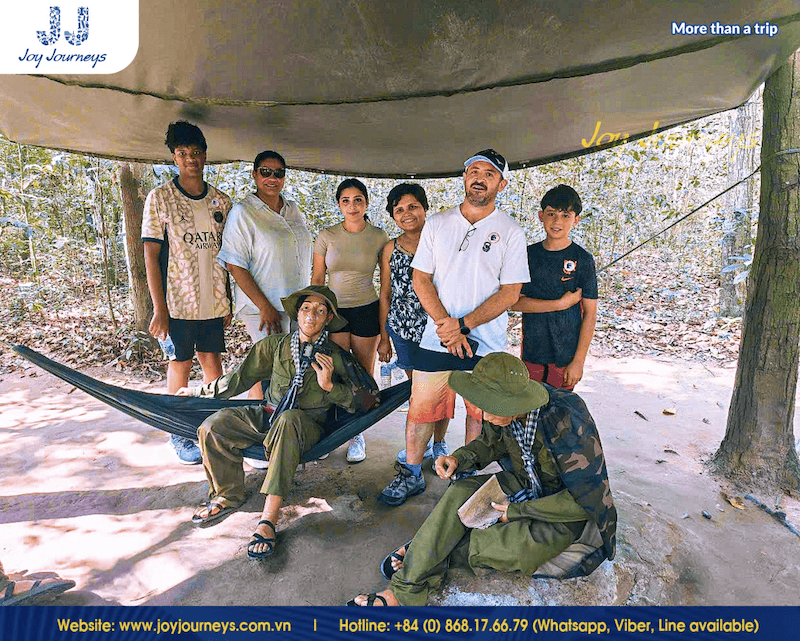
>> View Details and Pricing: 4 Best Cu Chi Tunnels Tour: Less Crowded & Budget-Friendly
Hygiene and Sanitation
Maintaining cleanliness while living underground Cu Chi presented extraordinary challenges. The cramped quarters, limited water, and constant presence of soil made basic hygiene difficult to maintain. Yet tunnel engineers designed remarkably effective systems given these constraints:
- Designated latrine areas positioned away from living and cooking spaces;
- Waste disposal systems that minimized disease risk;
- Bathing areas where residents could clean themselves with minimal water.
For women, life underground Cu Chi posed additional challenges during menstrual periods. With limited hygiene options and no ability to leave during heavy bombing campaigns, managing menstruation required remarkable resilience and mutual support among female residents.
The Tunnel Community
The Cu Chi tunnels life wasn’t merely about physical survival-it also involved creating functioning communities that maintained social cohesion despite the extreme circumstances.
Cu Chi Tunnels Families: Daily Life Underground
Contrary to what many might expect, Cu Chi tunnels families were not uncommon. In some areas, entire family units moved underground as bombing intensified. Children were born and raised in these subterranean communities, never knowing normal life above ground during their early years.
Family units maintained their structure despite the challenges:
- Children received education in makeshift underground classrooms.
- Family meals were prepared and shared communally.
- Cultural traditions and celebrations continued when possible.
- Older children often took on adult responsibilities early, helping with food production or tunnel maintenance.
The presence of children in the tunnels served as a powerful motivation for the community. Many fighters reported that seeing children adapt to these harsh conditions strengthened their resolve to continue fighting for a future where these young ones could live freely above ground.
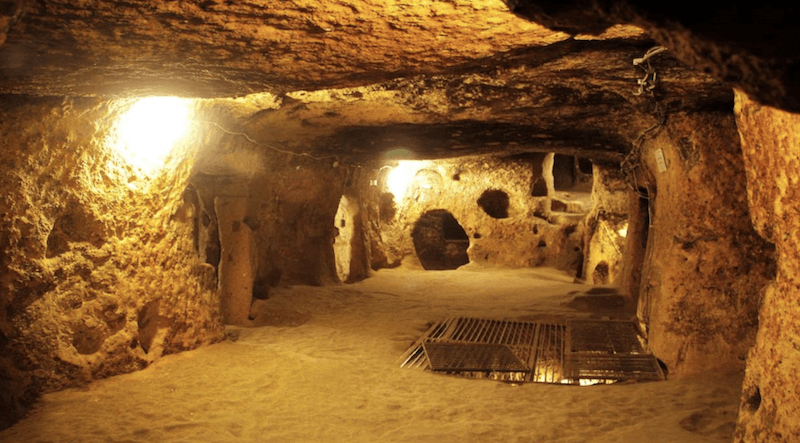
Community Support
The tunnel network functioned as a complete underground society with specialized roles for different members. This division of labor proved essential for survival:
- Some focused on tunnel maintenance and expansion.
- Others managed food production and distribution.
- Medical teams treated the wounded and ill.
- Military units planned and executed operations.
- Cultural groups maintained morale through performances.
Despite the harsh conditions, efforts were made to maintain community spirit. Remarkably, some sections of the tunnel network featured theaters and music halls where performers would entertain troops and civilians with patriotic songs and plays. These cultural activities played a crucial role in maintaining psychological resilience amid the hardships of life in the Cu Chi tunnels during the war.
Life in the Cu Chi Tunnels during the war: Challenges and Dangers
How did people survive in the Cu Chi tunnels given the numerous threats they faced? Their existence combined remarkable courage with constant vigilance against multiple dangers.
The Constant Threat of Attack
The primary purpose of the tunnels was protection from American and South Vietnamese forces, but this didn’t make them entirely safe havens. The tunnel warfare strategy involved constant risk:
- American “tunnel rats” soldiers specifically trained to enter and clear tunnel sections;
- Chemical attacks as U.S. forces pumped tear gas and other chemicals into tunnel entrances;
- Bombing raids that could cause cave-ins or structural damage;
- Attempts to flood tunnel sections.
The Viet Cong fighters living in the tunnels developed numerous countermeasures, including emergency escape hatches, water traps to block gas, and elaborate defense systems. Each day brought the possibility of discovery and attack, creating a perpetual state of alertness among tunnel dwellers.

How Did People Survive in the Cu Chi Tunnels Despite Health Risks?
Disease represented a major threat to those living in Cu Chi tunnels. Malaria became the second-largest cause of death after combat wounds. A captured Viet Cong report suggested that at any given time, approximately half of a People’s Liberation Armed Forces (PLAF) unit suffered from malaria, and “one-hundred percent had intestinal parasites of significance.”
Other health challenges included:
- Respiratory issues from poor air quality;
- Skin infections from constant exposure to damp soil;
- Nutritional deficiencies from the limited diet;
- Injuries from tunnel collapses or accidents in the dark.
Medical care in the tunnels was remarkably sophisticated given the limitations. Underground hospitals featured operating rooms where procedures were conducted using instruments sometimes fashioned from bomb fragments. Blood transfusions were performed using bicycle pumps and rubber hoses. Medical supplies included traditional Vietnamese remedies alongside Western medicines often procured by bribing ARVN soldiers in Saigon.
Life Underground Cu Chi: The Psychological Challenges of Tunnel Living
Perhaps one of the most overlooked aspects of Cu Chi tunnels life was its psychological impact. Living in constant darkness, confined spaces, and under the perpetual threat of death created extreme stress:
- Claustrophobia affected many residents, particularly new arrivals.
- The inability to stand upright for extended periods created physical and mental strain.
- Constant sounds of bombing above ground created ongoing trauma.
- Separation from wider family and community networks added to the emotional burden.
To counter these psychological challenges, community leaders organized activities to maintain morale, including political education sessions, cultural performances, and regular community meetings where people could share their experiences and support one another.
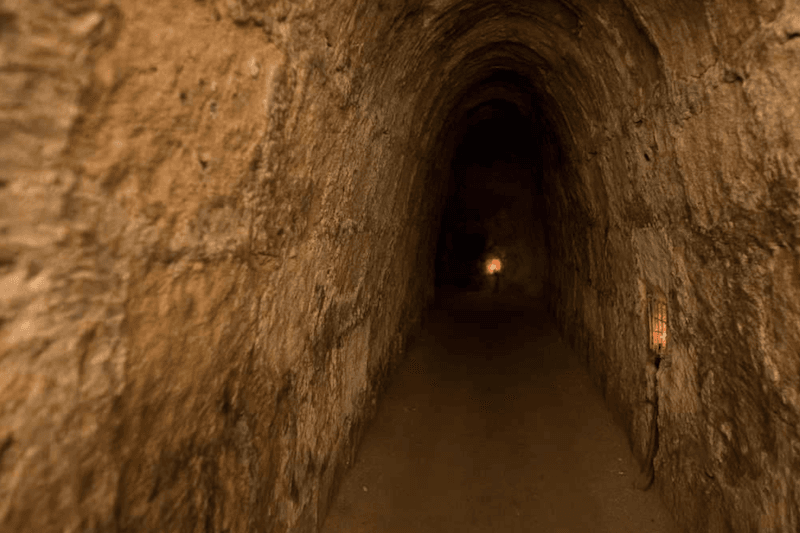
Ingenuity and Resilience in Daily Life in the Cu Chi Tunnels
The story of life underground Cu Chi is ultimately one of remarkable human adaptation, where resourcefulness and sheer determination enabled people to survive in the harshest of conditions. Faced with constant bombings, food scarcity, disease, and a lack of basic comforts, tunnel residents developed inventive solutions to maintain their physical and psychological well-being. From building sophisticated ventilation systems that disguised air vents as termite mounds, to crafting booby traps from salvaged war materials, every aspect of life reflected a deep commitment to survival and resistance.
Despite the darkness, heat, and cramped quarters, communities created a functioning underground society with kitchens, medical facilities, and even schools and meeting rooms. Their ability to transform a hostile, claustrophobic environment into a livable space is a powerful testament to the resilience of the human spirit. The Cu Chi Tunnels are not just a war site – they are a symbol of Vietnam’s unwavering will to endure, adapt, and overcome.
Living in Cu Chi Tunnels: Clever Innovations for Survival
The tunnel complex itself represents an extraordinary feat of engineering, but the innovations continued well beyond the initial construction:
Ventilation systems: Concealed air shafts prevented suffocation while remaining undetectable from above. These shafts were often disguised as termite mounds or integrated into tree root systems.
Multi-level design: The three-tiered system allowed residents to retreat deeper during heavy bombing:
- The first level (3 meters underground) could withstand bullets and chemical attacks;
- The second level (6 meters) resisted conventional bombing;
- The deepest level (12+ meters) provided ultimate protection during the heaviest bombardments.
Hoang Cam stoves: Perhaps the most famous innovation, these smokeless kitchens dispersed cooking smoke horizontally through a series of chambers before releasing it gradually far from the cooking site, preventing detection.
Trap systems: Booby traps protected tunnel entrances using recycled materials and indigenous knowledge. The psychological impact of these traps on American forces was significant, creating fear and hesitation that provided tactical advantages to the tunnel defenders.
Maintaining Morale: A Hidden Chapter in Cu Chi Tunnels History
Sustaining hope during years of underground existence required deliberate strategies. Community leaders recognized that physical survival alone wasn’t sufficient-people needed reasons to continue the struggle:
- Regular political education sessions reinforced the purpose of their sacrifices.
- Cultural performances and art created moments of joy amid hardship.
- Sharing news of military successes bolstered confidence in eventual victory.
- Celebrating traditional holidays maintained cultural connections.
- Collective decision-making gave people agency despite their confined circumstances.
This focus on morale represents one of the most remarkable aspects of Cu Chi tunnels history. Despite the extraordinary physical challenges, tunnel communities maintained their psychological resilience through years of underground existence during the Vietnam War.
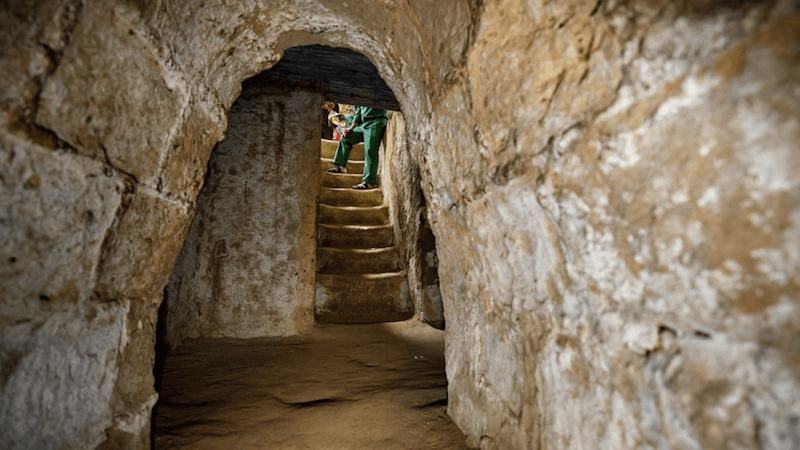
FAQs
How did people communicate within the tunnels?
Communication inside the Cu Chi tunnels utilized several methods. Within tunnel sections, residents used low voices, hand signals, and sometimes tapping codes on tunnel walls. For longer-distance communication, the tunnel system included designated courier routes with runners carrying messages between sections. Some larger tunnel complexes employed rudimentary telephone systems using salvaged wires and equipment. For communication with the outside world, radio operators worked from specially designed chambers with concealed antennas.
What did people eat in the Cu Chi Tunnels?
The primary staple was cassava (tapioca root), which could be cultivated near tunnel entrances and prepared simply underground. This was typically supplemented with foraged jungle plants, small amounts of rice when available, and occasionally protein from small animals trapped nearby. Food was often shared communally, with specially designated cooking areas using the innovative Hoang Cam smokeless stoves. During particularly intense fighting periods when emerging was impossible, residents relied on stored preserved foods.
How did they deal with sickness and injuries?
Underground hospitals treated both illness and combat injuries using a combination of Western medicine and traditional Vietnamese remedies. These facilities included makeshift operating rooms where surgeries were performed using adapted equipment-sometimes fashioned from salvaged military materials. Malaria represented the biggest health challenge, with approximately half of all fighters affected at any given time. Traditional herb treatments supplemented limited pharmaceutical supplies, and preventative measures included strict sanitation protocols in food preparation and waste disposal areas.
What happened to the people who lived in the tunnels after the war?
After the war ended in 1975, many tunnel residents emerged to rebuild their lives above ground, often facing significant health issues resulting from years of underground living. Some remained in the Cu Chi area, while others relocated throughout Vietnam. The tunnels themselves were partially preserved as historical monuments, with sections at Ben Dinh and Ben Duoc developed for tourism. Many former tunnel residents served as early guides, sharing firsthand accounts of their experiences. Some tunnel communities maintained strong bonds formed during the war years, creating support networks that continue to this day.
Discover the realities of Cu Chi Tunnels life – from daily survival underground to the ingenious systems built during wartime. For a deeper, more meaningful experience at the Ben Duoc site, book a guided tour with Joy Journeys, where expert storytelling brings history to life. Visit joyjourneys.com.vn or call Hotline +84 (0) 868.17.66.79 to plan your unforgettable journey into one of Vietnam’s most iconic historical landmarks.



Related Posts
Saigon’s “Flower Market Replica”: Where To Find Them
Ho Chi Minh City’s floral charm is not limited to its bustling wholesale markets. Imagine wandering through a place where vibrant petals, fragrant blooms, and the spirit of traditional Vietnamese markets come alive—without the overwhelming crowds. A flower market replica captures that magic, blending the beauty of fresh flowers with the charm of a curated, […]
Is it Safe to Travel to Vietnam Right Now? A Complete 2025 Guide
Vietnam has emerged as one of Southeast Asia’s most captivating destinations, drawing millions of visitors annually with its rich culture, stunning landscapes, and incredible cuisine. However, many travelers still ask: Is it safe to travel to Vietnam right now? This comprehensive guide provides you with everything you need to know about Vietnam travel safety in […]
Ho Chi Minh Cu Chi Tunnels Tour: The Ultimate Guide
The Cu Chi Tunnels stand as one of Vietnam’s most remarkable historical sites, offering visitors a profound glimpse into the ingenuity and resilience displayed during the Vietnam War. For travelers, a Ho Chi Minh Cu Chi tunnels tour represents an essential experience that combines education, adventure, and deep cultural understanding. This comprehensive guide will help […]